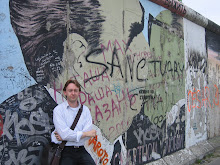Sunday, 10 January 2010
Hit the North has moved
Saturday, 31 October 2009
Back soon
 Hit the North is taking a break in November.
Hit the North is taking a break in November. Friday, 23 October 2009
The witching hour

The lady behind the counter of the Lancaster City Museum lingers over the words. "We persecuted people, we locked them up, we killed them," she smiles with a macabre frisson of delight. "The aura of doom and gloom still hangs over the city".
I never had Lancaster down as a hotbed of ghoulish goings-on. But, as thoughts turn to things that go bump in the night this week, I find the spectre of Lancaster's grisly past looms ever large over the medieval Market Square.
Lancaster Castle, the ancestral seat of the Dutchy of Lancaster, is forever associated with the Pendle Witch Trails, one of the largest executions for witchcraft ever staged in Britain.
Seven women and two men from the nearby villages of Pendle Hill lost their lives to the noose in Lancaster on August 20, 1612. Today the castle remains a courthouse and a prison - as it has been since the Middle Ages.
Exploring the grounds on a chilly winter afternoon, I find the tower (pictured above) where they spent their final hours still stands with its raven-black weather vane, and the place of the public execution is now a weather-stained stone wall behind stout, forbidding railings.
The group of alleged witches was blamed for the death of 17 of their neighbours with the main evidence against them collected from their own confessions. Their preferred method of evil-doing was, apparently, to make a clay model of their victim.
Overall, an estimated half million men women and children were burnt at the steak across Western Europe at the 17th-century height of the witch trails.
King James I of England was obsessed with witchcraft and suspicious of the Catholic faith. Matthew Hopkins, the king's appointed Witchfinder General, had arrested over 120 people in the south of England for witchcraft by his death in 1646.
The 400th anniversary of the Trails in 2012 will ignite interest in the folklore of the Pendle Witches. Meanwhile, you can follow a brown-sign trail from Lancaster to Clitheroe and onto Barrowford, taking the old gallows road from Lancaster, moving through the Trough of Bowland and culminating with the climb up Pendle Hill, where wolves and wild boar once roamed free.
Early next year The Lancashire and Blackpool Tourist Board is to launch a series of heritage trails, which will highlight some of the region's lesser-known and macabre attractions.
But were the Pendle Witches possessed by supernatural powers, or the innocent victims of an age obsessed with the ways of the Wicca?
Only by exploring the ancient landscape of Lancashire can we try to uncover the grisly truth.
Saturday, 10 October 2009
Anyone round here want to hire a travel writer?

Friday, 2 October 2009
Airport lounging

Eight minutes. That's the average time it now takes - apparently - to pass through security at Manchester Airport's Terminal One following its £50m refit.



